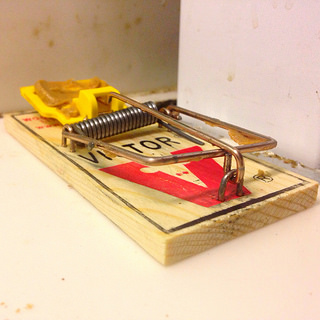How to Place Snap Traps for Mice
By Chris Williams on August 20, 2014.

Expanded trigger snap trap baited with peanut butter
Before placing mouse traps around your home, do a little checking for signs of mice. Traps should be placed in areas of mouse activity, so look for mouse droppings, gnawed places, feeding damage, or nest material. Mice follow the same paths or runways when they travel, usually moving along walls or other objects. Ideally you want to place the traps across their travel routes, perpendicular to the wall with the trigger end of the trap against the wall. Since mice sometimes jump over traps placed in their travel route, some pros will place 2, 3, or more traps side by side so that the mouse has to land on a trap.
Also place traps near accumulated droppings and near nest sites. Use many traps if you want to be successful; you almost certainly have more mice than you think you have.
If you’re placing the traps anywhere that children or pets could come in contact with them, place traps inside a box to avoid trapping cute, little “non-mice.” Whether you use a child-resistant, plastic bait station designed for that purpose or just a shoebox with a hole in one end depends on the age and curiosity of the young ones in your household.
To Bait or Not to Bait?
If you are placing your traps properly, across mouse travel routes, you don’t always need to bait the traps (especially if using expanded trigger traps). Mice will investigate the traps and may be caught anyway. Bait doesn’t always have to be food either. Attaching nesting material such as cotton balls to the trap works very well to capture pregnant females. See “What’s the Best Bait for Mouse Traps?”
Professional exterminators know that snap traps with an expanded trigger plate are more effective at trapping since the mouse has a larger area to step on. Bait is stolen less often from these traps.
Whether you are baiting your traps or not, it’s a good idea to place the traps unset for a few days to let the mice investigate and get used to them. Then set the traps all at once.
What About the More Humane, Live-Catch Mouse Traps?
If you choose to use one of the humane or live traps, understand that some studies have shown that these traps are generally much less effective at trapping mice due to their design. Even if you do catch a mouse unharmed, it will only survive for several hours in the small, enclosed trap. If you don’t check the trap two or three times a day, the mouse may die anyway in a less than humane manner. If you intend to release the trapped mouse outside, realize that it may die due to stress, competition, and lack of habitat. A snap trap is one of the most humane ways to kill a mouse since it usually breaks the mouse’s back, causing immediate death.
If you’re rather not deal with mice at all, give Colonial Pest a call. We do mice so you don’t have to!
Photo credit: stevendepolo / Foter / Creative Commons Attribution 2.0 Generic (CC BY 2.0)